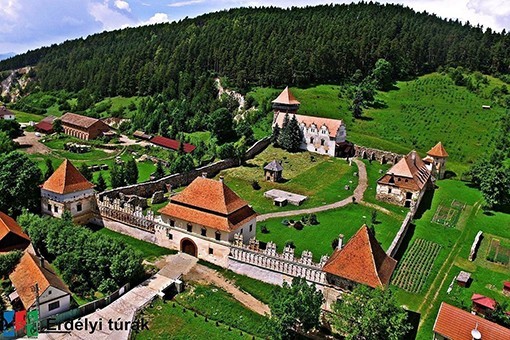Lázár CastleThe castle of Lazarea, Harghita County, is a major tourist attraction, alongside the Gothic cathedral in Ditrau, only 6 km away. The 19th Century Hungarian writer, historian, ethnographer and journalist Orban Balazs mentions the Lazarea Castle in his writings: “a noteworthy old castle of the Lazar counts.” What distinguishes it from other castles is its Renaissance architectural style. The Lazarea Castle, built under Prince Bethlen Gabor in the first half of the 17th Century, is one of the few in Transylvania built in this style.  As the name of the castle indicates, the castle belonged to the Lazar family, of the local nobility, which was rising in the early Baroque age. It was built in several stages, by successive generations of the family. The first stage began in the 15th Century, when the stone tower above today’s portal was built. The tower used to be surrounded by a wooden fence, intended to protect the housing area. The name Lazar was first mentioned in the early 15th century, in a document dating back to 1406. A century later, in 1506, Lazar Andras, a notable Szeckler, chairs a local council. He is the one who orders the construction of a stone wall and of a watchtower. His son, Lazar Janos I, extends the wall to its current size, builds two rooms above the gate tower and later adds a second floor. The text on the gate, written with Gothic characters, mentions the year 1532 as the date when the construction was completed. But with the Ottoman power on the rise in the 16th Century, which the local nobility regarded as a threat, one of Janos’ sons, Lazar Istvan II, strengthens the defence features of the building. He builds the outer bastions, reinforces the weaker walls facing the Szarmany Hill, where he builds double walls and several towers, and consolidates the north-western bastion. The best-known member of the family, Lazar Istvan IV, was born in 1597. Much of his huge wealth was the result of the privileges he received in exchange for services provided to the Prince of Transylvania, Bethlen Gabor. He monitored the completion of the fortifications of the castle to which a council hall, a Franciscan monastery and a prison were subsequently added. The Italian Renaissance style with turrets and loopholes dates back to his time. This style can also be encountered in Austria, Slovakia, Poland and Hungary. Lazar Istvan the 4th got involved in the anti-Ottoman fight started by Bethlen Gabor and continued by his successors. His son, Ferenc, was the ally of the Habsburgs and at 22, years of age, in 1702, he received the title of count. His promising career was ended in 1706 by the emperor of Austria for the fact that Ferenc had allied with the anti-Habsburg movement of Rakoczi Ferenc 2nd. In 1707 Austrian general Acton set the castle on fire in retaliation for the fact that Rakoczi’s insurgents had taken refuge there. The fire marked the beginning of the decline of the castle that was never re-constructed to reach its former grandeur. During the 18th century the castle was the bone of contention between heirs while by mid 19th century it had gone derelict. Reconstruction works only partially managed to turn the castle into a local museum and an area for fine artists to create new works. The castle in Lazarea, is today a contemporary art museum. It is also home to a permanent exhibition of painted eggs and zoological specimens. The council hall is the venue for medieval, choral and chamber music concerts while the premises of the castle offer visitors a full panorama of the surroundings. |